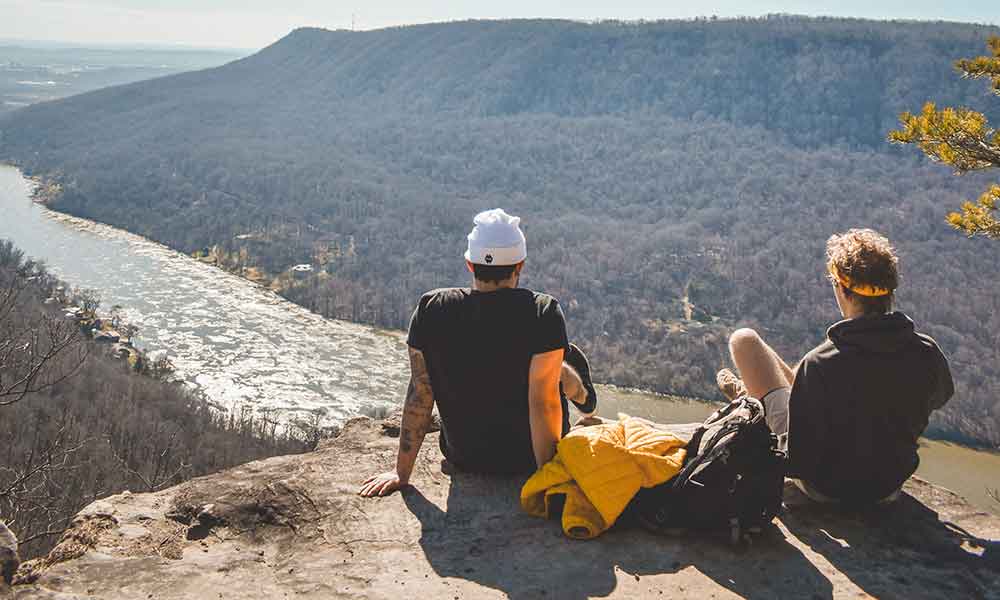You can find hiking trails across the United States and they are a great way to see the country in all its glory, from rock formations to mountain peaks, deserts, and blooming forests. But when did we first start creating marked trails and enjoying the many benefits of this outdoor activity?
When was hiking invented, do we know who the first hiker was, and when was the first hiking trail created?
Hiking in Ancient Times
The ancient Greeks believed in the twelve gods of Olympus, all of which were thought to live atop Mount Olympus.
For many years, people wondered why the Greeks didn’t just climb the mountain and then immediately change their beliefs when they realized there were no mighty gods perched on its summit.
In fact, they almost certainly did climb Mount Olympus and not only did they continue believing in Zeus and his brethren, but they may have incorporated those climbs into their religious practices.
The key question is whether those treks constituted a “hike”.
The same question could be asked for many other ancient ancestors. We know, for instance, that humans have been taking long and leisurely walks for thousands of years. Some were religious in nature, others were prescribed for health reasons, and then there were those who just wanted to get out of the claustrophobic and dirty cities.
Technically, you could argue that Hannibal “hiked” across the Alps with his Carthaginian army just as Alexander the Great “hiked” across Greece, Anatolia, Persia, and India.
Roman emperor Hadrian hiked mountains in Europe and trekked across large parts of the Roman border in North Africa while Caesar covered northern Europe on a quest to paint the map red.
Many early explorers also hiked across rugged and challenging terrain, including Lewis and Clark, and then you have the humans that migrated thousands of miles.
If we include these walks in the history of hiking, we’d need to go back further than any written record. In fact, we’d probably keep going back until we reached the point where humans stopped crawling on all-fours and began exploring their surroundings on two feet.
But this is not quite what you think of when you picture hiking.
Hiking is more of a modern pursuit. It’s something that you do for fun, and not for transport or religious regions. It’s also something that takes you through valleys, over mountain peaks, and across carefully plotted trails, as well as something that involves specific tools and special equipment.
It’s a recreational activity, and if we narrow it down as such, the history of hiking is not quite as extensive or as untraceable.
When Was Hiking Invented?
One of the first recorded instances of someone hiking for pleasure came from Francesco Petrarca, an Italian poet and scholar.
Petrarca wrote about a hike that he took on Mont Ventoux with two servants and his brother. He recorded this hike on April 26, 1336, and specifically noted that he did it as a recreational activity and not for religious/transport reasons or even for health benefits.
Some have claimed that Petrarca was the first to climb this mountain, others have said he was the first to climb for pleasure, and others still have dismissed these claims and believe his story was fictional.
Whether Petrarca was lying or not doesn’t really matter, as he almost certainly wasn’t the first person to go on a long and difficult walk just for the fun of it.
The idea of walking for pleasure developed in the 18th century and become much more commonplace. Poets and artists often walked for inspiration, including the great William Wordsworth, who regularly walked in the Lake District (a mountainous region in the UK), but also took walking tours of northern Europe.
Albrecht von Haller was also a keen hiker and wrote about the activity in his poem Die Alpen, published in 1732.
Abel Crawford is one of the first people credited with hiking in the United States and actually worked to create a hiking trail in New Hampshire back in 1819.
Henry David Thoreau and Ralph Waldo Emerson were also keen hikers in the 19th century and helped to spark a renewed interest in outdoor recreation.
Why Would Early Humans Care About Hiking?
Our ancestors walked a lot more than we do. They were also more in touch with nature and regularly ventured into the wilderness to hunt and gather food.
Our ancestors were also aware of the health benefits of long walks and many early doctors prescribed fresh mountain air for a host of ailments.
What is the Oldest Hiking Trail in the World?
Although it’s not easy to determine when hiking was invented or who took the first hike, we do have an idea of when the first hiking trail was created.
A hiking trail is simply a cleared path designed for the purpose of hiking, and the first one (that we know of) was created by Ethan and Abel Crawford, a father and son hiking team.
The Crawfords created the Crawford Path back in 1819. It spans 8.5 miles of mountainous terrain and converges with the famous Appalachian Trail.
This ancient hiking trail crosses the alpine zone and leads hikers to the summer of Mount Washington.
What is the Origin of the Word “Hike”?
The word “hike” comes from the word “hyke”, which may have evolved from Scots and Middle English words meaning “to move” and “to jerk”.
What are the Oldest Hiking Clubs?
There are a number of clubs associated with hiking, walking, and caring for the natural environment. The US-based Sierra Club, for instance, organizes hiking trips and alpine expeditions and was first founded way back in 1892.
The Ramblers Association was founded in 1935 and focuses entirely on walking/hiking/trekking, known as “rambling” in the United Kingdom. The club has over 100,000 members in the United Kingdom and is one of the biggest hiking clubs in the world.







